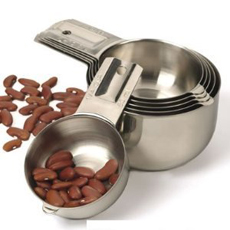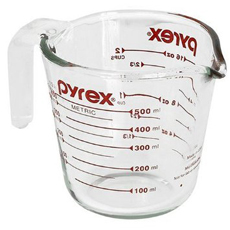TIP OF THE DAY: Measure Ingredients Using The Right Measuring Cups
|
If you bake, take note:
Liquid and dry measuring cups are not interchangeable. Precision is especially critical in baking, which is an exact science. Variations can compromise the recipe, especially if it’s a fragile recipe like macarons and angel food cakes. That’s why so many professional recipes are listed by weight (grams) instead of volume. The challenges of using the wrong type of cup to measure ingredients: |
The classic liquid measuring cup. Photo courtesy Pyrex. |
|
|
MEASURING WET INGREDIENTS Liquid measuring cups are see-through, either glass or plastic. A good liquid measuring cup has extra space between the topmost gradation mark and the rim, so with a full measure (e.g., one cup), the liquid won’t splash out when carried (see the photo above). Fill the cup until the top of the liquid meets the correct gradation line when viewed at eye level. Some people keep the cup on the counter and bend down to see the gradation and the meniscus. If you have a steady hand, you can lift the cup to eye level. |
||
 Dry measuring cups. Metal measuring cups are preferable to plastic, which can warp in the dishwasher. Photo courtesy RSVP. |
READING THE MENISCUS
Liquids in a container have a tendency to form a meniscus, the Greek word for crescent.* The meniscus is the curve in the upper surface of the liquid, caused by surface tension as it touches the wall of the container. When viewed from the side of a clear measuring cup, the meniscus looks like a line of liquid wrapped around the inside of the cup. The accurate measure is from the bottom of the meniscus line, not the top. The bottom of the meniscus should be touching the appropriate gradation line on the cup. *The Greek menískos,crescent, is diminutive of mene, moon. |
|
|
MEASURING DRY INGREDIENTS If you want absolute precision, weigh dry ingredients. Put the ingredients in the measuring cup, having adjusted the scale to deduct the weight of the empty cup. Note that each ingredient has a different weight: One cup of sugar does not weigh the same as one cup of flour. Whether dry or liquid, it takes a wee bit more time to measure ingredients precisely; but the results are worth it. |
||



